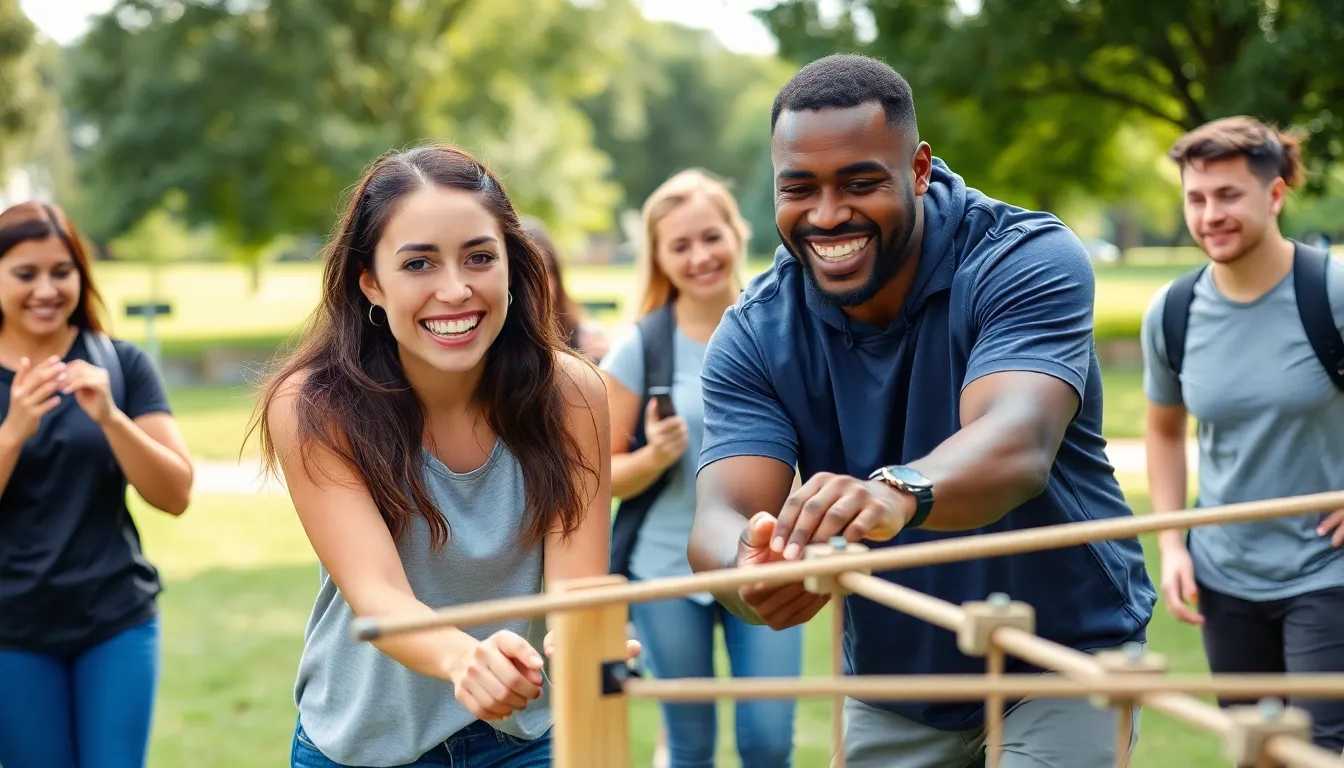In today’s fast-paced work environment, teams often find themselves tangled in a web of challenges. What if there was a way to turn those challenges into opportunities for growth? Team building problem-solving activities not only sharpen skills but also strengthen bonds, making the workplace feel less like a battleground and more like a well-oiled machine—or at least a quirky one with a few laughs along the way.
Table of Contents
ToggleUnderstanding Team Building Problem Solving Activities
Team building problem solving activities provide structured opportunities for colleagues to collaborate and enhance their skills. Participants engage in tasks designed to challenge their critical thinking and communication abilities, fostering a sense of unity and trust. These activities range from escape rooms to scavenger hunts, promoting not only strategic planning but also creativity.
Facilitators often use activities tailored to specific team dynamics, targeting weaknesses such as conflict resolution or decision-making. By participating in these exercises, teams can identify individual strengths and weaknesses, enhancing overall performance. Regular engagement in these activities contributes to a positive workplace culture that values innovation and collaboration.
Challenges presented during these activities simulate real workplace scenarios, allowing teams to practice problem-solving techniques in a safe environment. Teams learn to navigate obstacles together, reinforcing their ability to work under pressure. Different activities cater to various learning styles and preferences, ensuring inclusivity and engagement among all team members.
Successful implementation of these activities leads to tangible benefits, including improved productivity and morale. Research shows that organizations investing in team development initiatives experience lower employee turnover. Regular problem solving events instill a growth mindset, encouraging teams to embrace challenges as opportunities for advancement.
Benefits of Team Building Problem Solving Activities

Team building problem-solving activities offer numerous advantages that extend beyond just a fun experience. These activities enhance team dynamics, fostering a supportive and productive work environment.
Enhancing Communication
Communication improves as team members engage in problem-solving scenarios. Participants learn to express ideas clearly while articulating their thoughts and actions. Each activity requires sharing information, which fosters a more open atmosphere. Colleagues develop active listening skills when they focus on understanding differing perspectives. Trust builds as individuals feel valued for their contributions, leading to a stronger team connection. Effective communication enables quick resolution of misunderstandings, creating a collaborative spirit that persists beyond the activities.
Boosting Collaboration
Collaboration receives a significant boost from structured problem-solving activities. These exercises encourage individuals to work together toward a common goal. Participants rely on one another’s strengths, increasing efficiency and creativity. Diverse skill sets complement one another as colleagues form balanced teams. By sharing resources and insights, team members discover innovative solutions that may not occur in solo efforts. Collective problem-solving fosters interdependence, reinforcing a sense of unity and shared purpose among team members.
Types of Team Building Problem Solving Activities
Team building problem solving activities vary in type and setting, enhancing collaboration and communication among team members. Two main categories include outdoor and indoor activities.
Outdoor Activities
Outdoor activities provide teams with dynamic environments for problem solving. These activities often include obstacle courses, ropes courses, and team challenges such as capture the flag. Teams engage in strategic planning while navigating physical tasks. Participants strengthen their bonds through shared experiences in nature, promoting trust and open communication. Challenges faced in the outdoors often mimic real-world situations, requiring quick thinking and adaptability. These scenarios enhance critical thinking skills as teams collectively work towards a common goal.
Indoor Activities
Indoor activities offer structured environments for teams to tackle problem-solving exercises. Common options include escape rooms, team trivia challenges, and simulations of workplace scenarios. Teams collaborate to find solutions under pressure, enhancing their decision-making skills. These activities foster creativity as colleagues brainstorm unique approaches to challenges. The focus remains on improving communication and collaboration, allowing team members to learn from each other’s strengths. Engagement in these exercises builds a foundation for trust and camaraderie, translating into more effective workplace dynamics.
Implementing Team Building Problem Solving Activities
Implementing team building problem solving activities requires strategic planning and careful consideration of team dynamics.
Choosing the Right Activities
Selecting appropriate activities depends on the team’s specific needs and goals. Teams benefit from identifying both strengths and weaknesses before choosing a task. For example, if the primary aim is to improve communication, activities emphasizing dialogue and collaboration work best. Conversely, when focusing on decision-making skills, challenging scenarios that require quick thinking may be more effective. Various activities exist, including indoor escape rooms, outdoor obstacle courses, and virtual problem-solving games. Each type presents unique advantages, allowing teams to practice problem-solving in diverse contexts. Ultimately, aligning chosen activities with desired outcomes fosters a more engaging and fruitful experience.
Measuring Success
Evaluating the effectiveness of team building activities plays a crucial role in organizational development. Success can be measured through participant feedback, observing team interactions, and assessing performance improvements. Surveys conducted immediately after activities gather insights on participant engagement and skill enhancement. Monitoring post-activity communication patterns helps highlight changes in collaboration and trust among team members. Furthermore, tracking productivity and morale indices provides quantitative data on long-term impacts. Organizations that analyze these metrics can refine future activities to ensure continuous growth and adaptability, reinforcing the importance of investing in team development initiatives.
Team building problem-solving activities are vital for fostering a collaborative workplace. They not only enhance individual skills but also strengthen team dynamics. By engaging in these structured exercises, teams can navigate challenges effectively while building trust and communication.
The benefits extend beyond the activities themselves. Improved morale and productivity create a positive environment where innovation thrives. As teams learn to tackle real-world problems together, they cultivate a culture of continuous improvement and adaptability.
Investing in these activities pays off in the long run. Organizations that prioritize team development experience lower turnover and higher employee satisfaction. Embracing team building problem-solving activities is a strategic move toward a more engaged and high-performing workforce.







